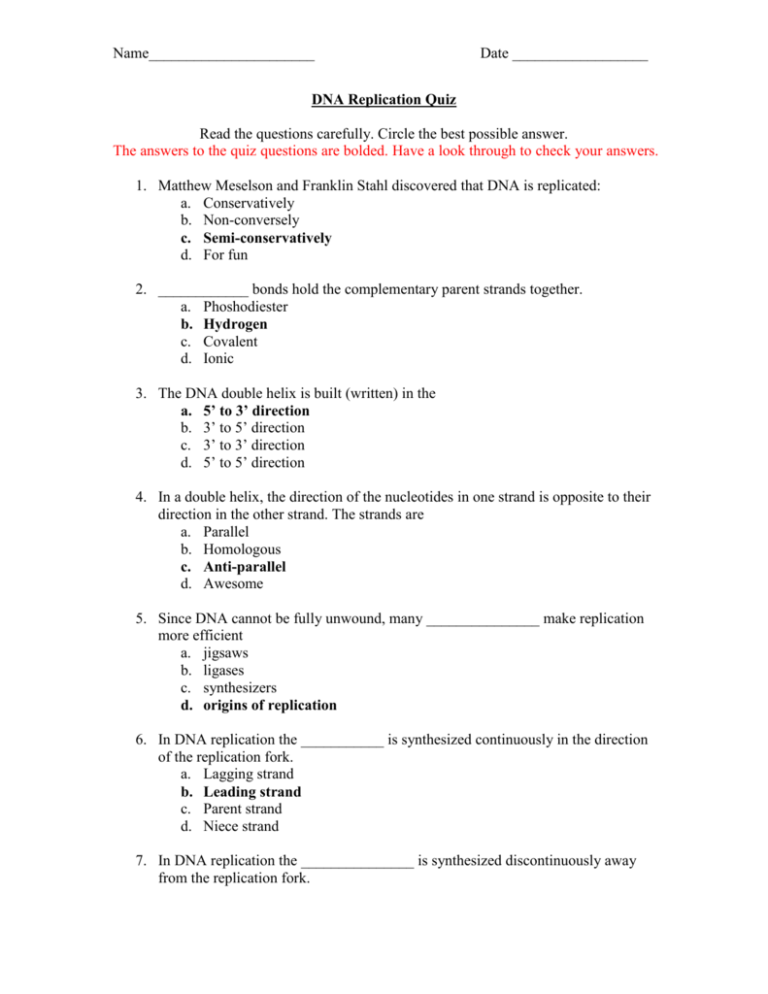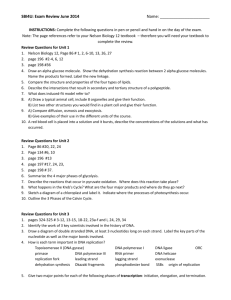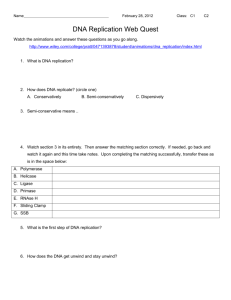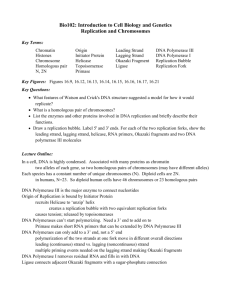DNA Replication Quiz: High School Biology
advertisement

Name______________________ Date __________________ DNA Replication Quiz Read the questions carefully. Circle the best possible answer. The answers to the quiz questions are bolded. Have a look through to check your answers. 1. Matthew Meselson and Franklin Stahl discovered that DNA is replicated: a. Conservatively b. Non-conversely c. Semi-conservatively d. For fun 2. ____________ bonds hold the complementary parent strands together. a. Phoshodiester b. Hydrogen c. Covalent d. Ionic 3. The DNA double helix is built (written) in the a. 5’ to 3’ direction b. 3’ to 5’ direction c. 3’ to 3’ direction d. 5’ to 5’ direction 4. In a double helix, the direction of the nucleotides in one strand is opposite to their direction in the other strand. The strands are a. Parallel b. Homologous c. Anti-parallel d. Awesome 5. Since DNA cannot be fully unwound, many _______________ make replication more efficient a. jigsaws b. ligases c. synthesizers d. origins of replication 6. In DNA replication the ___________ is synthesized continuously in the direction of the replication fork. a. Lagging strand b. Leading strand c. Parent strand d. Niece strand 7. In DNA replication the _______________ is synthesized discontinuously away from the replication fork. Name______________________ a. b. c. d. Date __________________ Lagging strand Leading strand Parent strand Nephew strand 8. Yesterday we learned about DNA Replication, how many steps did we say there were? a. 3 b. 5 c. 7 d. 9 9. The first step in the process of DNA replication involves _________. (Hint, think of the rope). a. Gyrase which creates tension in the double helix. b. Gyrase which relieves tension from the double helix. c. Helicase which creates tension in the double helix. d. Helicase which relieves tension from the double helix. 10. _________ are used to speed up the process of DNA replication a. nucleotides b. phosphodiester bonds c. enzymes d. Okazaki fragments 11. In the second step ________ breaks the bonds which hold the complementary parent strands together. a. Gyrase b. Primase c. Helicase d. Single-stranded binding proteins 12. When Ms. Nolan and Tyler shook hands, they were demonstrating how ______________ keep the newly exposed strands from re-bonding to each other. a. Gyrase b. Primase c. Helicase d. Single-stranded binding proteins 13. Before DNA polymerase III can begin its job, what must happen? a. DNA polymerase I must create a base for it to start at b. Primase lays down thymine and cytosine c. DNA polymerase III doesn’t need any help d. Primase lays down RNA primers Name______________________ Date __________________ 14. DNA polymerase III adds the appropriate ____________________ to the _____ end of the new strand, using the template strand as a guide. a. Deoxyribosenucleoside triphosphates; 5’ b. Nucleotides; 3’ c. Deoxyribosenucleoside triphosphates; 3’ d. Nucleotides; 5’ 15. The lagging strand is composed of segments known as a. Pkazoki fragments b. Brgan fragments c. Ruzycki fragments d. Okazaki fragments 16. The RNA primers must be replaced with the appropriate deoxyribosenucleotides. The enzyme that accomplishes this is called a. Primase b. DNA polymerase I c. DNA polymerase II d. DNA polymerase III 17. Once the primers have been replaced, DNA _________ joins the gaps in the Okazaki fragments. a. Primase b. Cohesivase c. Parisase d. Ligase 18. What does the last step of DNA accomplish? Which two enzymes are used in the process? Proofreading. DNA Polymerase I and DNA Polymerase III. What do you understand about DNA replication? What confuses you about DNA replication? Thank you for answering these questions honestly.






